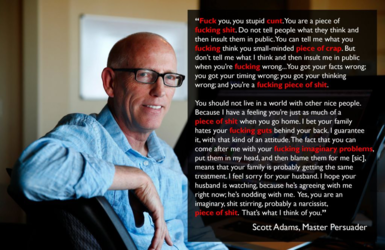
Scott Raymond Adams is a published author, creator of one of the most profitable and popular newspaper comic strips, “Dilbert”, a licensed hypnotist, and a self absorbed Twitter addicted terminally online boomer dedicated to telling the world what he thinks no matter how much it damages his reputation.
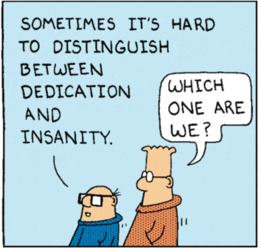
Early Life
Adams was born June 8, 1957, in New York, and had a relatively comfortable upbringing despite having autism. In 1979 started his career working as a teller at Crocker National Bank, where he claims to have been held at gunpoint twice in the span of two months. Soon, he joined a management training program, and began to climb his way up the corporate ladder. In 1986 he returned to graduate school, earning a MBA from UBC Berkeley, a school he has since publicly denounced. That same year he shifted to working at Pacific Bell, and through that experience started developing what would eventually become Dilbert, inspired by the personalities and experiences he came across His attempts to pitch the idea were unsuccessful, until 1989, when the strip was picked up by United Media. From there, the strip slowly grew and grew to the point where Adams could afford to become a full time cartoonist. Dilbert had become a American phenomenon, and a staple of the comics page. But as his fame and fortune grew, so did his ego
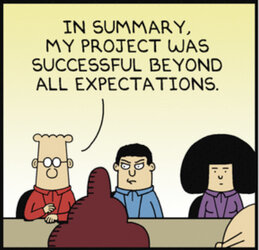
The Dilbert Hole
In 1996, inspired by his hatred of having Dilbert forced upon him, Tristan Farnon created his own parody Dilbert comic, cutting out the written dialogue of several strips, and replacing it with more edgy content (that is relatively tame by today’s standards)

Tristan put the comics on his obscure website, “Leisuretown”, where they laid dormant for months, until one day Tristan received a legal threat from United Syndicate and Scott Adams. The document also contained a direct threat from Adams, a free speech advocate, which read,
Tristan, not wanting to go to court over this, took down the strips. This resulted in a public out-roar from fans of the site. The comics disappeared for a long time, until Tristan partnered with rotten dot com, a more popular shock site who was willing to risk the wrath of Adams, where they stayed for two years under the title of “The Dilbert Hole”.“Do you want to go to jail?”
Eventually, the strips were discovered by United, and taken down again, replaced by a copy of the cease and desist letter that had been sent.
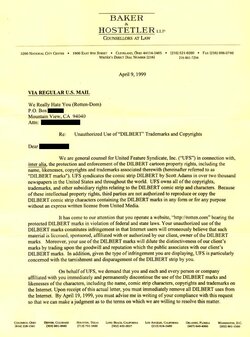
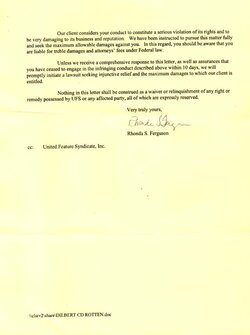
The legal team was still not satifised, demanding every instance of the term “Dilbert” be removed

Rotten complied, but by this point many mirrors of the strips had been created, making it pointless for United/Adams to continue this pursuit. Tristan voiced his thoughts on the matter with the following:
What I don't know is why Scott Adams would feel compelled to contact me personally. I'm allowed to disrespect Dilbert if I want to, I’ve suffered through years of insipid Dilbert-related merchandise staring at me from other people's cubicles. I've worked on software products code-named "Dogbert." It just got annoying. After awhile each strip ballooned up with industry keywords, and they grew indistinguishable from any other rectangle of syndicated bumper-sticker humor. Let's all honk if we love Dilbert.
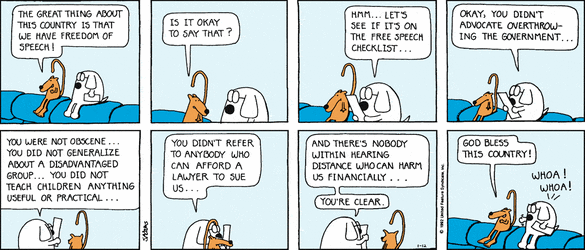
The Dilberito
Scott Adams wasn’t content just being one of the most successful cartoonists of the era, he wanted to branched out into other ventures, specifically the food industry. In 1999 he founded “Scott Adams Food”, a company which proceeded to make one product in his lifetime. Wanting to promote his vegan lifestyle onto America, Adams had the idea to use his character to promote a vegan microwave burrito, called “The Dilberito”

Adams was confident in the products success, having a flash game/website made to promote it, and even going as far to describe it as “The blue jeans of food”. Unfortunately the product never caught on, and Scott Adams Food shut down operations in 2003. Adams originally claimed that The Dilberito’s failure was due to rival food makers sending secret agents into grocery stores to hide the product in the back of shelves, however Scott later reflected on the failure saying,
“The mineral fortification was hard to disguise, and because of the veggie and legume content, three bites of the Dilberito made you fart so hard your intestines formed a tail."
Stacey’s At Waterford

Before the Dilberito came into existence, Adams decided to heavily invest in a restaurant called “Stacey’s at Waterford”. It started off well, but soon started to struggle due to location, competition, etc. Eventually, after seeing how poorly his investment was doing, Adams decided to swoop in and take over control of the business in 2007, calling all the shots.
Already struggling financially, Adams sheer ineptitude at running a restaurant only aggravated the situation. Adams first move once he gained full control was to send himself and his employees on a wild goose chase to find a very specific set of window coverings in order to achieve the “perfect lighting”, which Scott viewed as more important in a restaurants success than “food, price, or location”. After wasting several meetings and days trying to find the right coverings and arguing with the staff, Adams eventually gave up. Adams was confident in his ability to run a restaurant, due to having grown up working in a family owned one, but would butt heads with employees due to his utter lack of knowledge on how the industry worked. Scott would take suggestions from fans on his blog on to improve the restaurant with little to no success. Adams tried to boost the restaurant’s fledgling customer count through slowly turning it into a glorified “DilbertEats”. He encouraged patrons to draw on blank comic panels, and he would put the “best” ones on his websites. He had plans to buy a flat screen TV that played an endless loop of Dilbert Strips. Despite the changes, Adams couldn’t keep the place afloat, and eventually the doors were closed.“I am highly experienced at making funny comics about managers, how hard could it be to transition from mocking idiots to being one?”
Some select quotes from employees during Adams tenure:
“I’ve been in this business 23 years, and I’ve seen a lot of things. He truly has no idea what he’s doing…. He’s a really nice guy, but he relies on his friends’ opinions”
“[Scott is] someone who should be shielded from tough decisions the way a crawling infant needs to be protected from household hazards.”
“We laugh and say we’re not going to let him watch the Food Channel, He’ll think he can run a restaurant”
In response to a rumor of Adams planning to make employees wear Dilbert themed uniforms:“At this point, I’m sure he wouldn’t care if we put cardboard on windows”
In response to Adams denying the rumors:“It is definitely not going to up our cool factor”
“I bet you six months from now, you walk in here and see the ties”
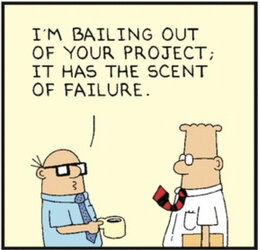
Zippy
Even at the height of his success, Adams still found the time to get into petty squabbles with other cartoonists. In 1998, Bill Griffith, known for his surreal strip “Zippy The Pinhead”, had this to say about the quality of Dilbert in an article.
Most successful cartoonists would most likely ignore this criticism, not giving it the time of day. Scott Adams is not most successful cartoonists, if he hears someone has something to say about him, he will respond, no matter how much it negatively impacts him.“Long since psychically kidnapped by the gaudy, mindlessly hyperactive world of television, (readers) no longer demand or expect comic strips to be compelling, challenging, or even interesting. Enter Cathy. And Dilbert. Sure, comics are still funny. It's just that the humor has almost no "nutritional" value. In the tiny space allotted to them, daily strips have all too successfully adapted to their new environment. In this Darwinian set-up, what thrives are simply drawn panels, minimal dialogue, and a lot of head-and-shoulder shots. Anything more complicated is deemed "too hard to read". A full, rich drawing style is a drawback. Simplicity, even crudity, rules.”
Adams proceeded to make two Dilbert strips parodying Zippy,


Bill then fired back the same year,

And that was the end of it.
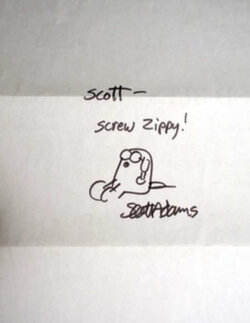
MetaFilter
On April 12 2011, a thread was made on the site Metafilter, discussing an article written by Scott for the Wall Street Journal in the subject of education. Threads discussing Adams opinions were somewhat common on this forum. The thread went as usual, until a new user by the name of “plannedchaos” began strongly defending Adams, and trying to debate the other users.
The forum users were quick to latch onto plannedchaos, and a back and forth was created.
This went on for a while, until plannedchaos finally revealed themselves to be Scott Adams
plannedchaos then left the forum for good, but the story started to spread far and wide, leading to Scott Adams making a blog post defending his actions. Here is a more condensed version with just the highlights, you can find the full post here

If Adams only got into meaningless drama like this, and kept to himself, there would be no point in following him. However throughout the years, whether it’s through his books, interviews, or the social media landscape, he has constantly tried to make people listen and care about what he has to say, embarrassing himself in the process.

Beliefs
Adams holds some bizarre/questionable beliefs and thoughts, that if questioned he will be provoked enough to respond and attempt to flaunt his intellectual superiority. In his mind if you disagree with him you are nothing but an ignorant troll.
Adams is a professional hypnotist, and strongly believes in “Affirmations”, a process where if you tell yourself something enough times, it will come true. He credits his life success to this practice, and has brought it up in multiple books, including
An example:"The Dilbert Future" page 246
"How to fail at almost everything and still win big" chapters 8, 24, 26, 37
"Dilbert 2.0: 20 Years of Dilbert" page 13
"God's Debris" page 115
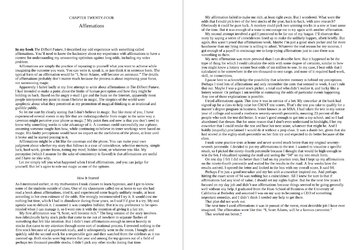
He has also written two books describing his views on religion
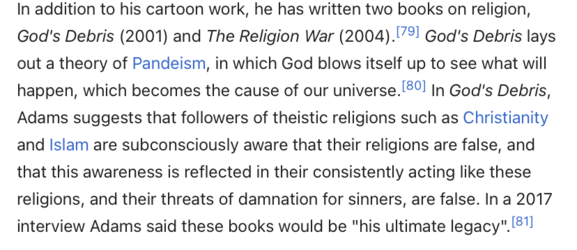
Scott’s political views are hard to track. He is very prone to flip-flopping his views, but can be described as a generic libertarian centrist, who leans right, and lives in fear of taxes
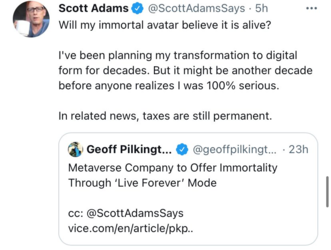
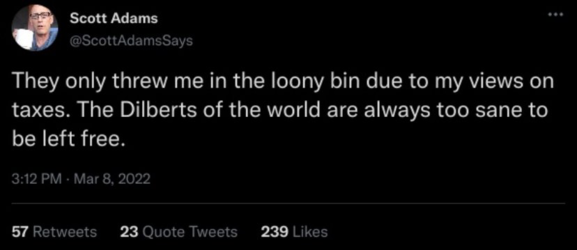
Adams is prone to contradicting himself, such as his explanations for why the Dilbert television show got cancelled

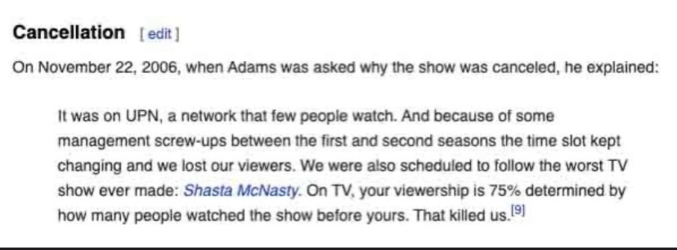
Adams also has the occasional generic Twitter musings on god/technology/politics, which are meant to sound deep and fascinating, but ultimately just ring hallow.
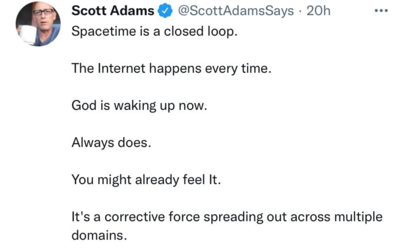
~foreshadowing~
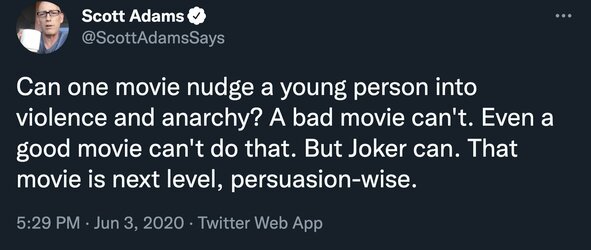
Scott, like many lolcows, cannot handle criticism, and will respond to even the slightest aggravation:

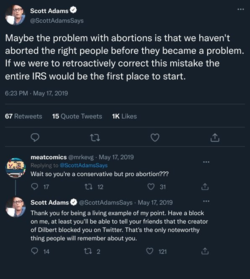
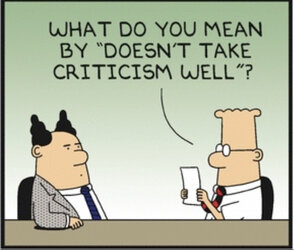
Live Stream Meltdown
Adams hosts a daily hour long livestream show, “Real Coffee With Scott Adams”, which he uses to spew forth his thoughts and musings to his boomer audience while drinking coffee. One day, a viewer named “Shelley”, left a comment in chat that critiqued Scott for flip flopping his views on Vaccinations during 2020, which resulted in Scott going on an unhinged rant and ending the stream:
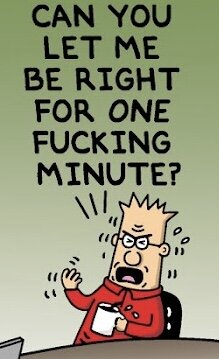
Personal Life
To touch on Adams personal life, while not very public, the bits and pieces available paint an interesting picture.
In the early 2000’s, Scott went to a gym, and started interacting with an employee, “Shelley Miles”. They presumably hit it off, and Scott married her in 2006, on a yacht no less. He gained two step children, Savannah, and Justin. Justin, (who will come up again later), died at the age of 18 in 2018 of a fentanyl overdose. Scott responded by going on stream, described what happened, and then condemned China for supplying the US with drugs.
When asked for further comment, Scott said, “I’ve read that maybe as many as 30,000 Americans a year die from fentanyl overdoses. That’s a Vietnam War-scale problem”.
He then went on to make an app called “WhenHub”, which claims to use blockchain technology to connect the user with an expert on any topic in a video call. Scott then went on to shill this app in response to a mass shooting (keep this in mind as well)

He later responded to the criticism in another stream
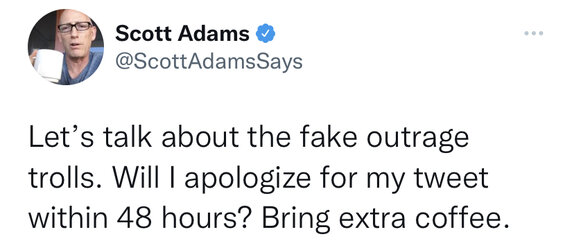
WhenHub may appear to be a generic political grift, but @Cyberpunk Panatela did some research, and found something much more shady behind the scenes.
The WHEN paper can be found hereIn 2017, the app concept was that of making short informational "whencasts" which could be pasted to the planned app and updated with time. The site had a demo of this:
2017 WhenHub, see bottom for some "whencasts"
In 2020 the focus changed dramatically (as did the app name, to "WhenHub INTERFACE"). Now "qualified" people signed on as "advisors" whom app users could consult at an hourly rate. There was also a promise that if your "organisation" signed up 5 or more "advisors", you would get up to US$100K - in Adams' new altcoin, the WHEN token(depending, of course, on how much money they brought in).
This version was apparently available for Apple, Microsoft and Android.
I presume that people were actually using the old site and this awakened Scott's latent greed. At around this time (Q1 of 2020) budding cryptobros were also starting to buy anything and everything "blockchain", so there was an attempt to capitalize on this too.
2020 WhenHub along with WHEN token bullshit
In December of 2020 the website broke and stopped displaying graphics correctly. This was never fixed.
Whenhub in terminal state of decay
In 2021 the site had devolved to a upload portal for MS apps and what looks like a section for scripts for the rapid production of such apps. It does not seem to be associated with Adams any more.
2021 - Start uploading!
Today the site is owned by GoDaddy, that esteemed consortium which enriches all our lives by providing the service of IP squatting.
I would say Adams got too greedy and priced himself out of the market. I'm surprised that he even tried this shit on. Most of his potential customers would probably remember the "Betterhelp" flameout and avoid downloading something so blatantly similar, which is before his exorbitant fees are even taken into consideration.
I got hold of a copy of the white paper for WHEN thanks to a single archive of the pdf on archive.org. I'll be including this at the end of my post.
This particular white paper looks like a dodgy company's prospectus. The first few pages are very short of text and profusely illustrated.
The use case for WHEN can be summarized as: WhenHub exists. People use WhenHub. Because of certain improvements to the app which totally can't be divulged because of patents which are being applied for, this app will somehow become based on the blockchain. This makes it essential to use cryptocurrency on WhenHub instead of USD. WHEN is the cryptocurrency which will solve this problem. Also, this is totally not a rugpull because we have working apps on the Apple and Google stores so we're not going anywhere.
This isn't the worst use case I have seen, as I've seen Mr. Ice Poseidon's CxCoin use case, and this is certainly better than that one. That doesn't mean it's fantastic though.
Adams also attempts to justify the need for WhenHub. In his opinion, people, especially contract workers, work too little. He claims that there is a lot of wasted time in the gaps between periods of work. WhenHub will solve this problem by letting these people fill these lacunae of "wasted time" with productive work.
I didn't go too deeply into the technical stuff except that WHEN is Ethereum-derived, like most other altcoins.
How the token would be used in practice:
Loser downloads WhenHub —> Loser buys WHEN(probably from Adams) to use on app —> Loser pays "expert" WHEN for "consultation" —> expert tries to cash out and takes a hit.
But wait! Surely I am mischaracterizing so distinguished a man as Scott Adams! The "WHEN ecosystem" is probably flourishing to this day - or is it?
The following chart is courtesy of coingecko.com. It is a plot of WHEN price and volume traded from launch to today.

Top graph is price against time, the following one is volume traded against time.
Shortly after launch, in July 2019, there is significant volume of trade in the token along with a price spike. This was probably due to WhenHub users buying WHEN to use on the app (and probably some Scott Adams fanboys buying to hold). If it were found out that a large proportion of this volume originated from wallets held or controlled by Scott Adams, I would not faint in shock.
July 2019 to about June 2020 sees low-volume trade with the token value taking a plunge then fluctuating at a very low level. This is probably "experts" frantically trying to cash out selling to a trickle of new users.
In June 2020 volume traded goes to almost nothing and the price hits the floor. (Late 2020 was also when WhenHub's website broke down). It's very possible that the apps were either pulled from or kicked off the distribution platforms at this time. This would invalidate the use case and flush whatever minuscule investor confidence remaining in the WHEN altcoin right down the shitter.
At present liquidity is so low that anyone holding this rubbish would have to trickle it onto the exchanges in minute amount hoping to get any offers at all. Scott Adams would probably consider this a "gap" of useless activity in that person's schedule and tell him to find something productive to do.
Apologies if I sound MATI. Mr. Fucking Adams' condescending attitude and hypocrisy really gets on my wick.
As promised, the WHEN white paper follows. Scott, the internet is forever, even if your website is not.
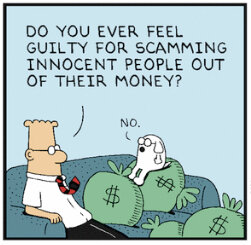
Scott and Shelley divorced in 2014, and Scott soon found a new lover, Kristina Basham, a much younger fashion model, who he made the Vice President of WhenHub. He even dedicated an entire blog post to praising her


On July 11th 2020, Adams and Basham got married. Adams presumably did not think the event was formal enough to wear a tie for.

On March 10th, 2022, he announced on stream that he was getting divorced from Basham. It is currently unknown if he has gotten into a new relationship.
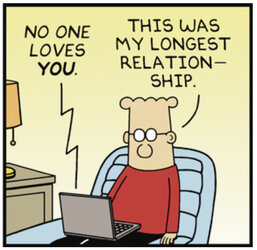
Mass Shootings
It seems whenever a horrific mass shooting happens, Scott always rushes to twitter in order to make his view known. Such as in the aftermath of the 2022 Uvalde shooting, where he penned a bizarre series of tweets stating how it should be legal for bullying victims to kill their bullies in order to prevent shootings
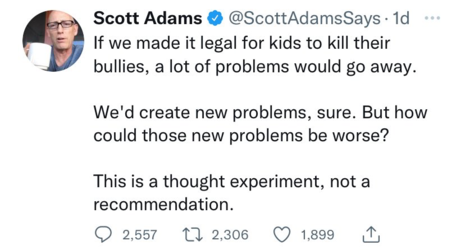
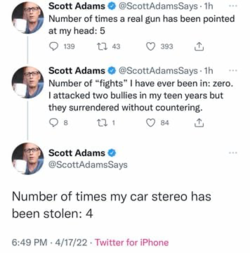
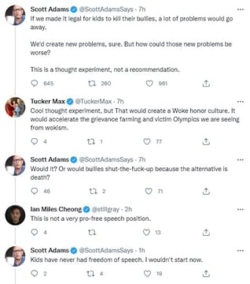
This continued a recent trend where
A. Scott posts something bizarre and stupid
B. People respond to it
C. Scott Adams trends on Twitter
And D. Scott Adams responds to the critics by calling them all bullies and trolls
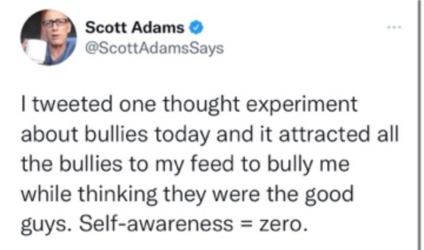
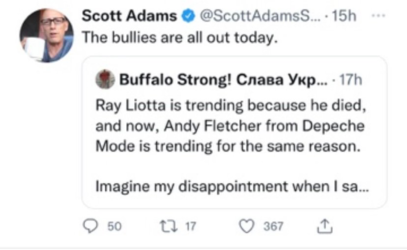
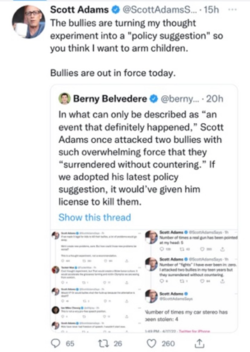
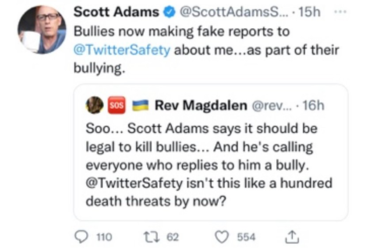
This incident lead Scott to publish his own research on the “distinct troll types”
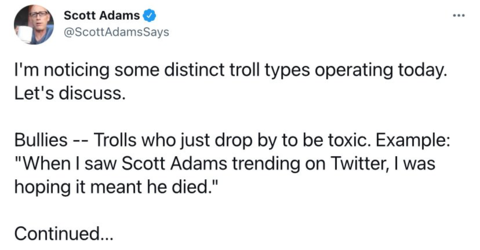
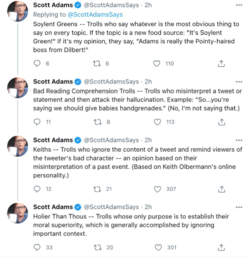
On July 6th 2022, in response to the Highland shooting, Scott hopped on Twitter again to post yet another rant, this time describing how he’s happy that Justin died of an overdose instead of becoming a shooter, that those are the only two options for mentally ill young men, and that nothing can be done to help these kinds of people
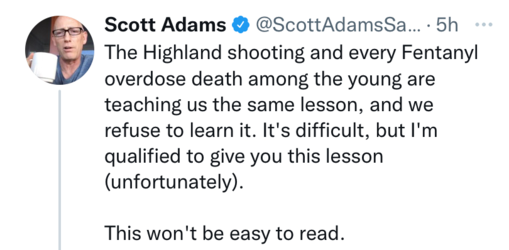
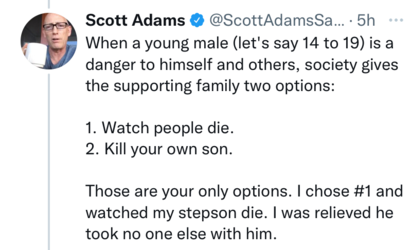
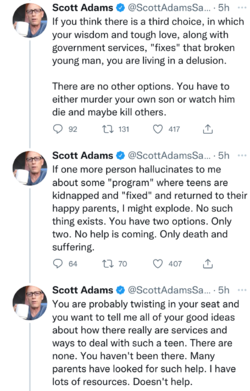
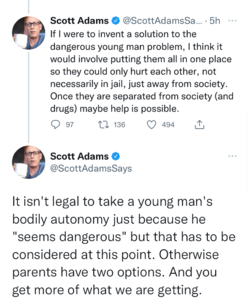
And so the cycle continues
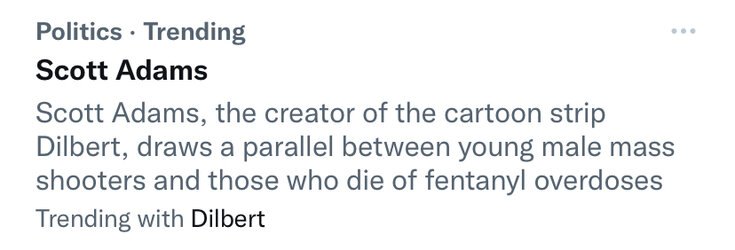
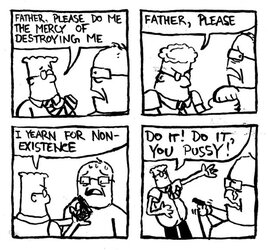
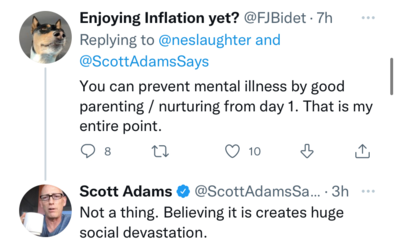
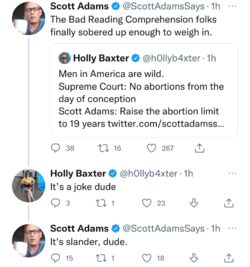
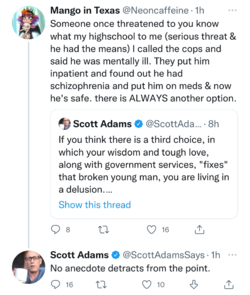
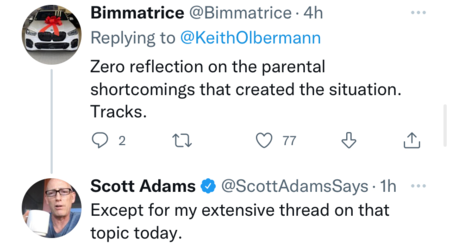
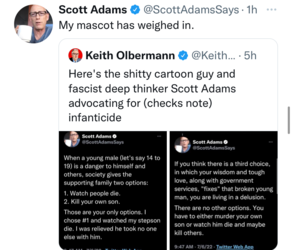
(Cow crossover)

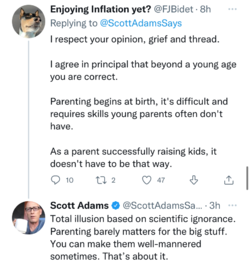
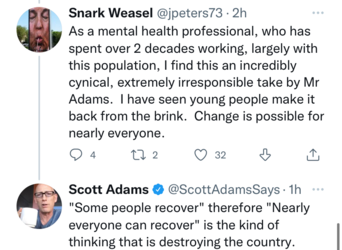
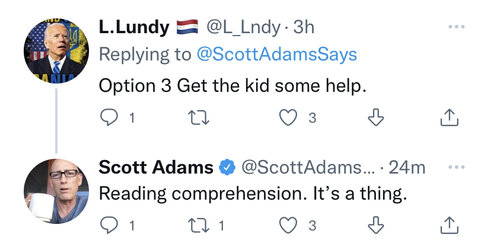
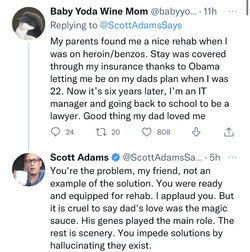
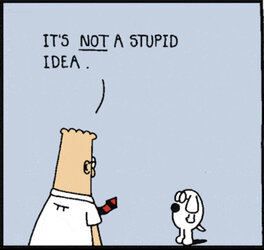
Conclusion
Regardless of whether you agree with Scott Adams political views or beliefs, his constant need to draw attention to himself and his narrow-minded world view make him a figure worth mocking. He is a political drifting out of touch boomer who desperately thinks he needs to be heard, and can’t take any form of no for an answer. He sees himself as a superior intellectual stuck in a world of filthy lower minded imbeciles who have made it their goal to bully and harass him. Scott is living proof that no matter how far someone gets, they can still end up a lolcow. Despite having almost everything a person could want, fame, money, a succesful creative outlet, he is still perpetually falling through a downward spiral of anger, ego, and Twitter addiction. He has ultimately become the overly analytical, narcissistic, unpopular, and hated engineer he created, except Dilbert still has hair.
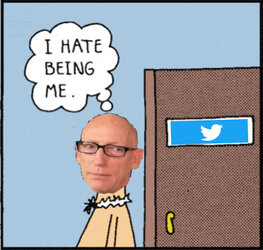
Links:
Youtube
Last edited:



